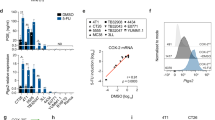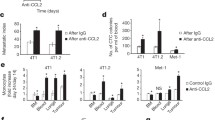Abstract
Cyclooxygenase (COX) inhibitors have demonstrated efficacy in models of human cancer but the relevant mechanisms have not all been elucidated. Both Cox-dependent as well as Cox-independent mechanisms have been implicated. Using a syngeneic model of metastatic breast cancer, we have investigated the effect of Cox inhibitors on NK functions that are critical to the control of metastatic disease. NK recognition of target cells is governed by a balance of activating and inhibiting receptors that bind ligands including MHC class I. We now show that treatment of tumor cells with the nonselective COX-1/COX-2 inhibitor indomethacin or the selective COX-2 inhibitor celecoxib leads to decreased expression of the MHC class I molecules Ld and Kd . Downregulated class I expression is associated with concomitant increased sensitivity to NK cell-mediated lysis. Both COX inhibitors limit tumor metastasis and this therapeutic effect is dependent on NK but not T cell function. Antimetastatic activity is also lost in the absence of interferon- γ (IFN-γ). Both COX inhibitors also suppress local tumor growth of subcutaneously implanted mammary tumor cells in immune competent Balb/cByJ mice. This therapeutic activity is lost in the absence of either CD4+ or CD8+ T cells, but is not compromised by the loss of NK activity. Thus, the mechanism of tumor inhibition differs in the context of local versus metastatic disease. Taken together, these findings are consistent with a mechanism not previously described, whereby COX inhibitors may relieve MHC-mediated inhibition of NK cytotoxicity leading to recognition and lysis of metastatic tumor cells.





Similar content being viewed by others
References
Bennett A, Berstock DA, Raja B, Stamford IF (1970) Survival time after surgery is inversely related to the amounts of prostaglandins extracted from human breast cancers. Br J Pharmacol 66:451–55
Fulton AM, Heppner G (1985) Relationship of prostaglandin E and natural killer sensitivity to metastatic potential in murine mammary adenocarcinomas. Cancer Res 45:4779–84
Goodwin JS, Ceuppens J (1983) Regulation of the immune response by prostaglandins. J Clin Immunol 3:295–315
Goto T, Herberman RB, Maluish A, Strong DM (1983) Cyclic AMP as a mediator of prostaglandin E-induced suppression of human natural killer cell activity. J Immunol 130:1350–1357
Harizi H, Juzan M, Pitard V, Moreau JF, Gualde N (2002) Cyclooxygenase-2-issued prostaglandin E(2) enhances the production of endogenous IL-10, which down-regulates dendritic cell functions. J Immunol 168:2255–63
Harris RE, Chlebowski RT, Jackson RD, Frid DJ, Ascenseo JL, Anderson G, Loar A, Rodabough RJ, White E, McTiernan A (2003) Breast cancer and nonsteroidal anti- inflammatory drugs: prospective results from the Women’s Health Initiative. Cancer Res 63:6096–6101
Harris RE, Namboodiri KK, Farrar WB (1996) Nonsteroidal antiinflammatory drugs and breast cancer. Epidemiology 7:203–205
Harris RE, Namboodiri KK, Stellman SD, Wynder EL (1995) Breast cancer and NSAID use: heterogeneity of effect in a case-control study. Prev Med 24:119–120
Hung W-C, Chang H.-C, Pan M-R, Lee T-H, Chuang L-Y (2000) Induction of p27 KIP1 as a mechanism underlying NS398-induced growth inhibition in human lung cancer cells. Mol Pharmacol 58:1398–1403
Joarder FS, Abou-Issa H, Robertson FM, Parrett ML, Alshafie G, Harris RW (1997) Growth arrest of DMBA-induced mammary carcinogenesis with ibuprofen treatment in female Sprague-Dawley rats. Oncol Rep 4:1271–1273
Kundu N, Fulton AM (2002) Selective cyclooxygenase (COX)-1 or COX-2 inhibitors control metastatic disease in a murine model of breast cancer. Cancer Res 62:2343–2346
Kundu N, Fulton AM (1997) Interleukin-10 inhibits tumor metastasis, downregulates MHC class I and enhances NK lysis. Cell Immunol 180:55–61
Kundu N, Smyth MJ, Samsel L, Fulton AM (2002) Cyclooxygenase inhibitors block cell growth, increase ceramide and inhibit cell cycle. Breast Cancer Res Treat 76:57–64
Kundu N, Yang Q, Dorsey R, Fulton AM (2001) Increased cyclooxygenase-2 (Cox-2) expression and activity in a murine model of metastatic breast cancer. Int J Cancer 93:681–686
Lala PK, Parhar RS, Singh P (1986) Indomethacin therapy abrogates the prostaglandin-mediated suppression of natural killer activity in tumor-bearing mice and prevents tumor metastasis. Cell Immunol 99:108–118
Liu X-H, Yao S, Kirschenbaum A, Levine AC (1998) NS398, a selective cyclooxygenase-2 inhibitor, induces apoptosis and down-regulates bcl-2 expression in LNCaP cells. Cancer Res 58:4245–49
Masferrer JL, Leahy KM, Koki AT, Zweifel BS, Settle SL, Woerner M, Edwards DA, Flickinger AG, Moore RJ, Seibert K (2000) Antiangiogenic and antitumor activities of cyclooxygenase-2 inhibitors. Cancer Res 60:1306–1311
Narko K, Ristimaki A, MacPhee M, Smith E, Haudenschild CC and Hla T (1997) Tumorigenic transformation of immortalized ECV endothelial cells by cyclooxygenase-1 overexpression. J Biol Chem 272:21455–21460
Oshima M, Dinchuk JE, Kargman SL, Oshima H, Hancock B, Kwong E, Trzaskos JM, Evans JF, Taketo MM (1996) Suppression of intestinal polyposis in APC delta716 knockout mice by inhibition of cyclooxygenase (COX-2). Cell 87:803–809
Pockaj BA, Basu GD, Pathangey LB, Gray RJ, Hernandez JL, Gendler S, Mukherjee P (2004) Reduced T-cell and dendritic cell function is related to cyclooxygenase-2 overexpression and prostaglandin E2 secretion in patients with breast cancer. Ann Surg Oncol 11:328–339
Ristimaki A, Sivula A, Lundin J, Lundin M, Salminen T, Haglund C, Joensuu H, Isola J (2002) Prognostic significance of elevated cyclooxygenase-2 expression in breast cancer. Cancer Res. 62:632–635
Rozic JG, Chakraborty C, Lala PK (2001) Cyclooxygenase inhibitors retard murine mammary tumor progression by reducing tumor cell migration, invasiveness and angiogenesis. Int J Cancer 93:497–506
Sharma S, Stolina M, Yang SC, Baratelli F, Lin JF, Atianzar K, Luo J, Zhu L, Lin Y, Huang M, Dohadwala M, Batra RK, Dubinett SM (2003) Tumor cyclooxygenase-2-dependent suppression of dendritic cell function. Clin Cancer Res 9:961–968
Smyth MJ, Hayakawa Y, Takeda K, Yagita H (2002) New aspects of natural killer cell surveillance and therapy of cancer. Nature Reviews (Cancer) 2:850–861
Stolina M, Sharma S, Lin Y, Dohadwala M, Gardner B, Luo J, Zhu L, Kronenberg M, Miller PW, Portanova J, Lee JC, Dubinett SM (2000) Specific inhibition of cyclooxygenase-2 restores antitumor reactivity by altering the balance of IL-10 and IL-12 synthesis. J Immunol 164:361–370
Taketo MM (1998) Cyclooxygenase-2 inhibitors in tumorigenesis (Part I). J Natl Cancer Inst 90:1529–1536
Thompson HJ, Jiang C, Lu J, Mehta RG, Piazza GA, Paranka NS, Pamukcu R, Ahnen DJ (1997) Sulfone metabolite of sulindac inhibits mammary carcinogenesis. Cancer Res 57:267–271
Tsujii M, Kawano S, Tsuji S, Sawaoka H, Hori M, DuBois RN (1998) Cyclooxygenase regulates angiogenesis induced by colon cancer cells. Cell 93:705–716
Walker W, Rotondo D (2004) Prostaglandin E2 is a potent regulator of interleukin-12 and interleukin-18-induced natural killer cell interferon-γ synthesis. Immunol 111:298–305
Yang L, Yamagata N, Yadav R, Brandon S, Courtney RL, Morrow JD, Shyr Y, Boothby M, Joyce S, Carbone DP, Breyer RM (2003) Cancer-associated immunodeficiency and dendritic cell abnormalities mediated by the prostaglandin EP2 receptor. J Clin Invest 111:727–735
Acknowledgements
Supported by the United States Department of Defense and the Department of Health and Human Services (to A.M.F.).
Author information
Authors and Affiliations
Corresponding author
Rights and permissions
About this article
Cite this article
Kundu, N., Walser, T.C., Ma, X. et al. Cyclooxygenase inhibitors modulate NK activities that control metastatic disease. Cancer Immunol Immunother 54, 981–987 (2005). https://doi.org/10.1007/s00262-005-0669-2
Received:
Accepted:
Published:
Issue Date:
DOI: https://doi.org/10.1007/s00262-005-0669-2




